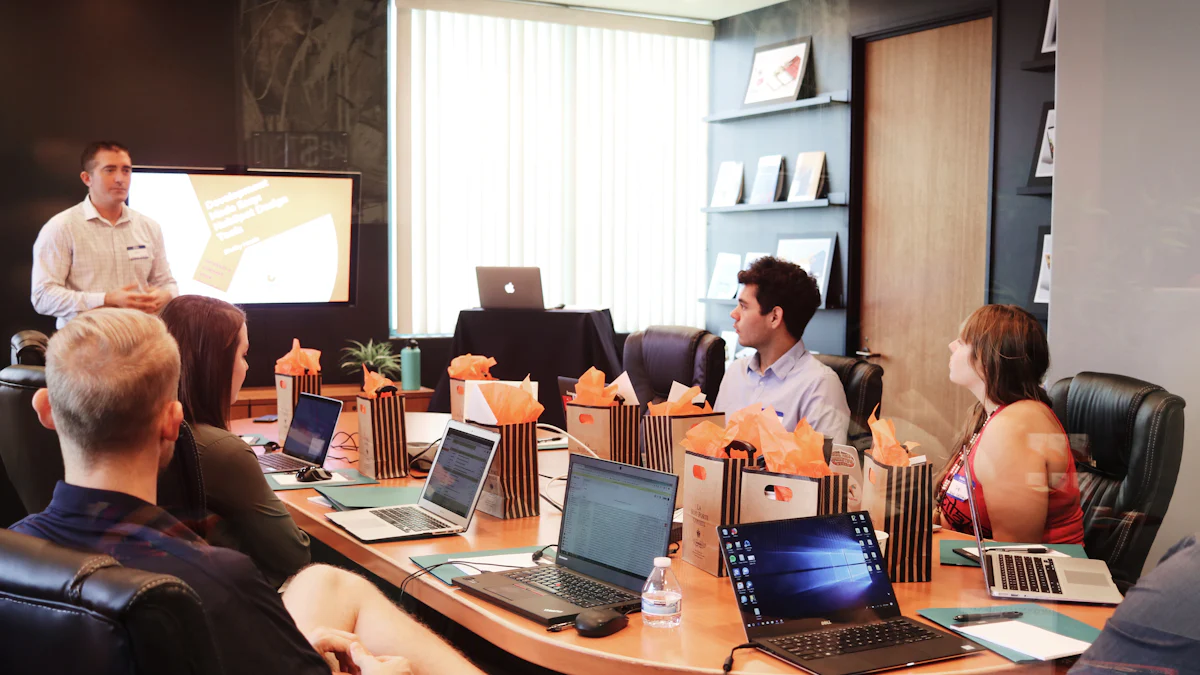How to Host an Effective Stakeholder Meeting

Effective stakeholder meetings play a crucial role in the success of any project. Studies show that projects with strong stakeholder engagement are 20% more successful. Engaging stakeholders improves decision-making and enhances project outcomes. This approach fosters open dialogue, builds trust, and ensures long-term sustainability. A structured method for conducting these meetings will be discussed to maximize these benefits.
Identifying Objectives and Stakeholders

Define Meeting Objectives
Clarify the purpose of the meeting
A clear purpose sets the foundation for a successful stakeholder meeting. The purpose should align with the overall goals of the project. This alignment ensures that every discussion remains relevant and focused.
Lori Harris from Harris Whitesell Consulting emphasizes, "Successful stakeholder meetings are a direct result of the intention, alignment, and purpose behind the strategy."
Set specific, measurable goals
Setting specific, measurable goals provides direction and clarity. These goals should be realistic and achievable within the meeting's timeframe. Clear goals help in evaluating the meeting's success.
Define what needs to be accomplished.
Ensure goals are measurable to track progress.
Align goals with the broader project objectives.
Identify Key Stakeholders
Determine who needs to be involved
Identifying key stakeholders is crucial for effective engagement. Stakeholders can include project sponsors, team members, clients, and other relevant parties. Each stakeholder brings unique insights and perspectives.
Izabela Lundberg from Legacy Leaders Institute advises, "Knowing as much as possible about the background of each stakeholder attending the meeting is paramount."
Assess stakeholder interests and influence
Understanding stakeholder interests and influence helps in prioritizing their involvement. Stakeholders with high influence and interest should receive more attention. This assessment ensures that critical voices are heard and addressed.
Evaluate the level of interest each stakeholder has in the project.
Assess the influence each stakeholder holds over project outcomes.
Prioritize stakeholders based on their interest and influence.
By defining clear objectives and identifying key stakeholders, the foundation for an effective stakeholder meeting is established. This preparation ensures that the meeting will be productive and aligned with the project's goals.
Preparation Steps
Create an Agenda
Outline key topics and time allocations
An agenda provides structure to the meeting. List key topics to discuss. Allocate specific times for each topic. This ensures that every important issue receives attention.
John Doe, a project management expert, states, "A well-structured agenda keeps the meeting focused and efficient."
Include time for Q&A and discussion
Allow time for questions and discussions. Stakeholders need opportunities to voice concerns and provide input. This engagement fosters collaboration and ensures all viewpoints are considered.
Select Tools and Resources
Choose appropriate meeting platforms
Select a meeting platform that suits the needs of the participants. Consider factors like ease of use, accessibility, and features. Popular options include Zoom, Microsoft Teams, and Google Meet.
Jane Smith from Tech Solutions advises, "Choosing the right platform can significantly enhance the meeting experience."
Prepare necessary documents and materials
Gather all necessary documents and materials before the meeting. This includes reports, presentations, and any other relevant information. Distribute these materials to participants in advance.
Prepare Participants and Facilitators
Send out invitations and pre-meeting materials
Send invitations well in advance. Include the agenda and any pre-meeting materials. This allows participants to prepare and come ready to contribute.
Michael Brown from Meeting Masters suggests, "Early distribution of materials leads to more productive discussions."
Brief facilitators on their roles and responsibilities
Ensure facilitators understand their roles. Provide clear instructions on their responsibilities. Effective facilitation keeps the meeting on track and ensures objectives are met.
By following these preparation steps, the foundation for a successful stakeholder meeting is set. Proper planning and organization lead to more effective and productive meetings.
Conducting the Meeting

Start with Introductions and Objectives
Introduce participants and their roles
Begin the stakeholder meeting by introducing all participants. Clearly state each participant's role within the project. This introduction helps everyone understand who is present and their contributions.
Experienced facilitator emphasizes, "A warm introduction sets a positive tone and makes participants feel valued."
Clearly state the meeting objectives
Clearly articulate the objectives of the stakeholder meeting. Ensure that everyone understands the purpose and what needs to be achieved. This clarity keeps the meeting focused and aligned with the project's goals.
Project management expert, John Doe, advises, "Stating clear objectives at the start ensures that all discussions remain relevant."
Facilitate Discussion
Encourage participation from all stakeholders
Encourage active participation from all stakeholders. Create an inclusive environment where everyone feels comfortable sharing their views. This engagement enriches the discussion and brings diverse perspectives to the table.
Experienced facilitator notes, "Facilitators play a crucial role in making participants feel comfortable and ensuring their points of view are heard."
Keep the discussion focused and on track
Maintain focus throughout the stakeholder meeting. Use the agenda as a guide to keep discussions on track. Address any deviations promptly to ensure that the meeting remains productive.
Use time management techniques to adhere to the agenda.
Politely redirect off-topic discussions.
Summarize key points periodically to maintain clarity.
Summarize and Conclude
Recap key points and decisions
Summarize the key points and decisions made during the stakeholder meeting. This recap reinforces the main takeaways and ensures that everyone is on the same page. Clear summaries help in tracking progress and evaluating outcomes.
Michael Brown from Meeting Masters suggests, "A concise recap at the end of the meeting solidifies understanding and agreement."
Outline next steps and responsibilities
Outline the next steps and assign responsibilities. Clearly define who will handle each task and set deadlines. This clarity ensures accountability and keeps the project moving forward.
Assign specific tasks to individuals.
Set realistic deadlines for each task.
Ensure that all participants understand their responsibilities.
By following these steps, the stakeholder meeting will be effective and productive. Clear introductions, focused discussions, and well-defined next steps contribute to successful outcomes.
Follow-Up Actions
Distribute Meeting Minutes
Summarize discussions and decisions
Summarize the discussions and decisions made during the stakeholder meeting. Highlight key points and action items. Ensure that the summary is clear and concise.
Jane Smith from Tech Solutions advises, "A well-documented summary helps in tracking progress and maintaining accountability."
Share with all participants promptly
Share the meeting minutes with all participants promptly. Timely distribution ensures that everyone remains informed. Use email or a shared document platform for efficient dissemination.
Michael Brown from Meeting Masters suggests, "Prompt sharing of meeting minutes keeps everyone aligned and engaged."
Monitor Progress
Track action items and deadlines
Track all action items and deadlines diligently. Use project management tools to monitor progress. Regular tracking ensures that tasks are completed on time.
Assign specific tasks to individuals.
Set realistic deadlines for each task.
Use tools like Trello or Asana for tracking.
Provide updates to stakeholders regularly
Provide regular updates to stakeholders. Keep everyone informed about the progress of action items. Regular communication fosters transparency and trust.
Izabela Lundberg from Legacy Leaders Institute advises, "Regular updates keep stakeholders engaged and informed."
Continuous Improvement
Gather Feedback
Collect feedback from participants
Collect feedback from all participants after each stakeholder meeting. Use surveys or feedback forms to gather insights. Encourage honest and constructive input. This feedback will highlight areas for improvement.
Billah shares, "Mastering stakeholder engagement has been a game-changer for my projects. Personalizing communication, ensuring regular updates, and involving stakeholders in decisions have improved outcomes and built lasting relationships."
Analyze feedback for areas of improvement
Analyze the collected feedback thoroughly. Identify recurring themes and specific suggestions. Focus on areas that need enhancement. This analysis will provide actionable insights for future meetings.
Implement Changes
Adjust meeting processes based on feedback
Adjust meeting processes based on the analyzed feedback. Implement changes that address identified issues. These adjustments will improve the effectiveness of future stakeholder meetings.
Update the meeting agenda to include more interactive sessions.
Introduce new tools or platforms that enhance participation.
Modify the facilitation approach to better engage stakeholders.
Share improvements with stakeholders
Share the implemented improvements with all stakeholders. Communicate the changes clearly and explain their benefits. This transparency builds trust and shows a commitment to continuous improvement.
Billah emphasizes, "This approach has significantly boosted my project success rates."
By gathering feedback and implementing changes, stakeholder meetings will continually improve. This process ensures that each meeting becomes more effective and valuable for all participants.
Effective stakeholder meetings play a vital role in project success. Engaging stakeholders fosters open dialogue, builds relationships, and showcases transparency. Implementing a structured approach ensures careful planning and preparation. This method aligns with the project's goals and objectives.
"Successful stakeholder meetings result from intention, alignment, and purpose," emphasizes Lori Harris from Harris Whitesell Consulting.
Continuous improvement remains essential. Gathering feedback and implementing changes lead to better outcomes. Encourage adopting these strategies for more productive and efficient stakeholder meetings.
See Also
Creating an Engaging Agenda Template for Administrator Meetings
4 Key Tips for Running Productive Team Meetings
Becoming a Pro at Hosting Hybrid Zoom Meetings

